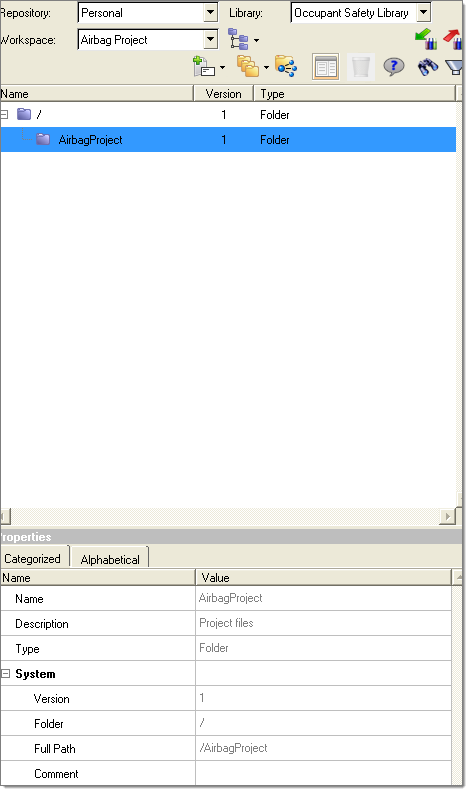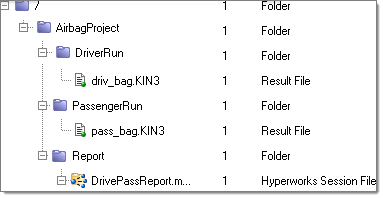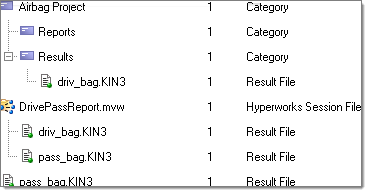HWCT-1300: Managed Libraries
In this tutorial, you will learn how to create a new library in the personal repository, create and manage workspaces in a managed library, and use the Organize browser to organize and explore categories and folders.
Create a New Managed Library and Workspace
- Create locations to store your new library and workspace, such as C:\MyLibraries and C:\MyLibraries\Workspaces.
- Open HyperMesh.
-
From the Assembly ribbon, click the
Organize tool group, and then select
Collaborate.
Figure 1. 
The Organize browser opens. - Select Personal from the Repository list.
- Select the Library drop-down and click New.
- Provide the following information: Name, Occupant Safety Library, Location, browse to and select C:/MyLibraries, and Type, CAE.
- Select the drop-down next to Workspace and click New.
- Provide the following information: Name, Airbag Project, and Working Directory, browse to and select C:/MyLibraries/Workspaces.
- Click OK.
-
Click OK again.
A new CAE library, Occupant Safety Library is created, along with a new associated workspace, Airbag Project.
Create Categories
-
Select the drop-down on the Category Mode/Folder Mode toolbar icon and select
Category Mode,
 .
.
Figure 2. 
-
Click the drop-down next to the New Content icon,
 , and
select Category,
, and
select Category,  .
.
- Provide the following information: Name, Airbag Project, and Description, Airbag Project files.
- Click Save.
- Repeat Steps 1-3 to create a second category. Provide the following information for the second category: Name, Results, and Description, Results files.
- Click in the Value column of the Category row.
- Click the browse folder.
- Check Airbag Project, and then click OK.
-
Click Save.
The Results Category is created within the Airbag Project category.
- Right-click the Airbag Project category and select .
- Provide the following information for the second category: Name, Reports, Description, Report files, and Category, Airbag Project.
- Click Save.
Create Folders
-
Select the drop-down on the Category Mode/Folder Mode
icon and select Folder Mode,
 .
.
-
Click the drop-down next to the New Content icon,
 , and select
Folder,
, and select
Folder,  .
.
- Provide the following information: Name, Airbag Project, and Description, Project files.
-
Click Save.
Figure 3. 
- Right-click the AirbagProject folder and select .
-
Provide the following information: Name, DriverRun, and
Description, driver simulation files.
The parent folder is AirbagProject.
- Click Save.
Populate the Library
-
Right-click the DriverRun folder and select .
The folder is set in the New Result File dialog.
-
Click in the Value column of the Category row, click the
browse folder,
 ,
check Results, and click OK.
,
check Results, and click OK.
- Click in the Value column of the Documents row, click the browse folder, and select the driv_bag.KIN3 file that you downloaded from AirbagProject\DriverRun from the hwe.zip directory.
-
Click Open.
The file is parsed and metadata is extracted and filled in automatically.
-
Click Save.
The content is added to the library.Note: You could continue to manually add contents one at a time to the library. Instead, you will add some additional contents in bulk.
-
Right-click the root library folder,
 , and
select Add Folder.
, and
select Add Folder.
-
In the Select Files/Folders dialog, click the
Add Folder icon,
 .
.
- Navigate to and select the directory AirbagProject.
- Click OK.
- Click OK in the notification dialog. Wait for the indexing process to complete. It should take just a few seconds, depending on your client.
-
When notified that the indexing is complete, click Yes
to refresh the Organize browser.
The contents are added to the library. Shown in Folder Mode:
Figure 4. 
Note: Notice the icon next to DrivePassReport.mvw indicating that it refers to other contents in the library. -
Click the Show/Hide References icon to show the
references, which were automatically created when the contents were added in
bulk.
Figure 5. 
-
Select the drop-down on the Category Mode/Folder Mode icon and select
Category Mode, . View the library contents in
Category Mode, as shown below.
Figure 6. 
Note: Category assignments do not get created automatically when bulk adding contents. - Right-click pass_bag.KIN3 and select Check-Out.
-
Right-click pass_bag.KIN3 and select Advanced
Edit.
The Advanced Edit dialog opens.
-
Click in the Value column of the Category row, click the
browse folder,
 ,
check Results, and click OK.
,
check Results, and click OK.
-
Click Check-In.
The content moves to the Results category.
- Repeat steps 15-18 and move DrivePassReport.mvw to the Reports category.
Summary
In this tutorial you worked with the Organize browser to add a new library to the out-of-the-box Personal repository.
Both a virtual category structure as well as a physical folder structure were created to organize the contents of the library. Subsequently, this library was populated, and automatic metadata extraction and reference creation was seen, allowing for information capture with no additional effort from you.